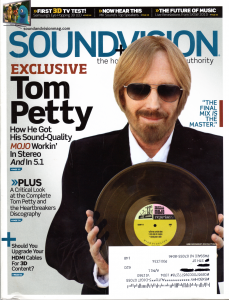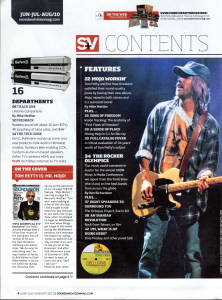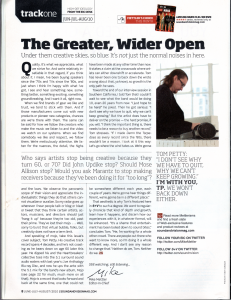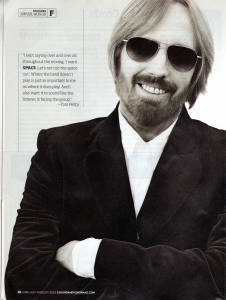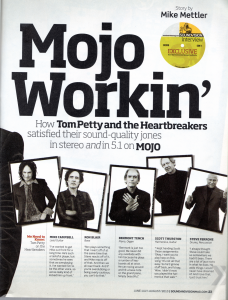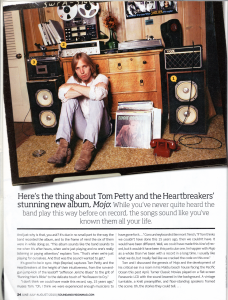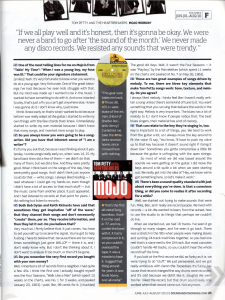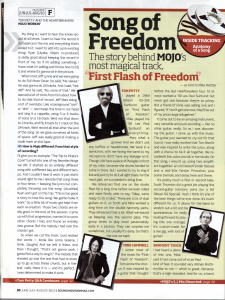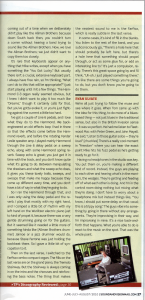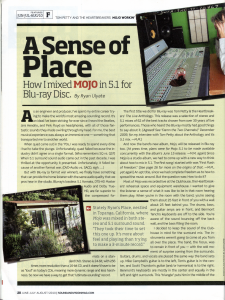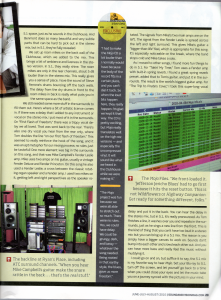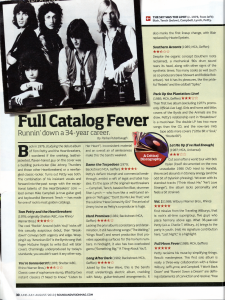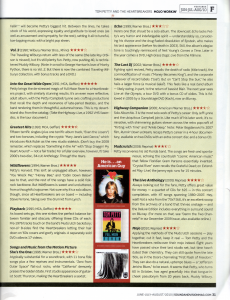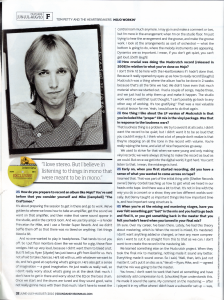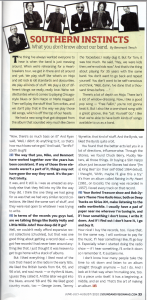Editor's Note: The last two articles did not appear in the magazine, but online.
On The Cover: Tom Petty Is: Mr. Mojo!
Sound & Vision - June-July-August 2010
Vinyl Accents: An S&V Exclusive!
Tom Petty proudly displays Side 1 of the first record of the 180-gram, two-LP version of his and the Heartbreakers' rollicking new album, Mojo. "We do vinyl for everything now," he says matter-of-factly to S+V Editor-In-Chief Mike Mettler in Southern California during the interview that serves as the backbone of our 12-page TP&THB feature, "Mojo Workin'," starting on page 22. Recounts Mettler: "Tom and I were looking at a few of the LPs that I had brought to the interview, like The Last DJ and Damn the Torpedoes, when he stopped to linger on Wildflowers. Tom said that when things got tough in the studio during the Wildflowers sessions, he'd motivate the players by saying, 'Come on, dammit! Just stay another hour, and I'll see you all at the Grammys!' And after that album won a pair of Grammys in 1996, he went to each of them and said, 'See? I told ya!'"
The Greater, Wider Open
By Mike Mettler
Sound & Vision - June-July-August 2010
Under them creative skies, so blue: It's not just the normal noises in here.
Quality. It's what we appreciate, what we strive for. And we're relatively insatiable in that regard, if you think about it. I mean, I've been buying speakers since the '70s and TVs since the '80s, and just when I think I'm happy with what I've got, I see and hear something new, something better, something exciting, something groundbreaking. And I want it all, right now.
When we find brands of gear we like and trust, we tend to stick with them. And if those manufacturers come out with new products or pioneer new categories, chances are we're there with them. The same can be said for how we follow the creators who make the music we listen to and the video we watch on our systems. When we find somebody we like and respect, we follow them. We're meticulously attentive. We listen for the nuances, the detail, the highs and the lows. We observe the panoramic scope of their vision and appreciate the individualistic things they do that others cannot visualize or auralize. So my radar goes up whenever I hear people talk or blog or bleat or tweet that they think certain artists, actors, musicians, and directors should just "hang it up" because they're too old, past their prime. They've lost their mojo ... Well, sorry to burst your virtual bubble, folks, but creativity does not have a term limit.
And speaking of mojo, take this issue's cover subject, Tom Petty. His creative track record spans 4 decades and he's not coasting as he bears down on age 60 later this year. He dipped his and the Heartbreakers' collective toes into the 5.1 surround sound audio waters with last year's Live Anthology Blu-ray Disc, and now he ups the ante with the 5.1 mix for the band's new album, Mojo (see page 22 for much, much more on all that). Mojo is a record that looks forward and back at the same time, one that could not have been made at any other time than now. It stakes a claim at the crossroads where artists can either downshift of accelerate. Tom has never been one to back down (he wrote a song about that, ya know), so growth is the only path he sees.
Toward the end of our interview session in Southern California, I told Tom that I couldn't wait to see what the band would be doing 10, even 20 years from now. "I just hope to be here!" he joked. Then he got serious: "I don't see why we have to quit, why we can't keep growing." But the artist does have to deliver on the promise -- the hard promise, if you will. "I think the important thing is, there needs to be a reason to buy another record," Tom stresses. "If I made Damn the Torpedoes as every record since the '80s, there wouldn't be a reason. I look at it this way: Let's go where the wind takes us. We're gonna be somewhere different each year, each couple of years. We're gonna hear things different, we're gonna be in a different place."
That aesthetic is why Tom's featured here in S&V to such a degree. We want to regularly chronicle that kind of depth and growth, learn how it happens, and discern how our experiences with it, in whatever format, will be enhanced. "It's a shame that entertainment has been boiled down to sound bites," concludes Tom. "Me, I'm working for a whole other crowd. There are people out there who want to know more, so I'm doing it a whole different way. And I don't see any reason to change that." Neither do we, Tom. Neither do we.
We Need To Know: Tom Petty and the Heartbreakers
By Mike Mettler
Sound & Vision - June-July-August 2010
Mike Campbell | Lead Guitar
"I've wanted to get Mike out front for a long time. He's such a tasteful player, but sometimes he sees that as overplaying it. I've wanted him to be the other voice, so we've really kind of kicked him up front."
Ron Blair | Bass
"Ron plays something that I react off of at the same time that Steve reacts off of it, and Mike reacts off of that. And then we all react back. And if you're overdubbing or being overly cautious, you can't do that."
Benmont Tench | Piano, Organ
"Benmont is just too good. We never did any overdubs with him because he plays a number of keyboards all at once. He can swing around and hit a bass note on the grand piano. Simply beautiful."
Scott Thurston | Harmonica, Guitar
"I kept handing Scott these assignments: 'Okay, I want you to play harp on this song.' It's not all that easy. So he'd gimme stuff back, and I'd say, 'Wow, I didn't know you played the harmonica that well.'"
Steve Ferrone | Drums, Percussion
"I always thought Steve could take us somewhere we hadn't been. There are a lot of jazz roots in what he does. He adds things I would never have dreamed of. And I love that. I just trust him."
Mojo Workin'
By Mike Mettler
Sound & Vision - June-July-August 2010
How Tom Petty and the Heartbreakers satisfied their sound-quality jones in stereo and in 5.1 on MOJO
Here's the thing about Tom Petty and the Heartbreakers stunning new album, Mojo: While you've never quite heard the band play this way before on record, the songs sound like you've known them all your life.
And just why is that, you ask? It's due in no small part to the way the band recorded the album, and to the frame of mind the six of them were in while doing so. "This album sounds like the band sounds to me when it's after hours, when we're just playing and no one's really listening or paying attention," explains Tom. "That's when we're just playing for ourselves. And that was the sound I wanted to get."
It's good to be in sync. Mojo (Reprise) captures Tom Petty and the Heartbreakers at the height of their intuitiveness, from the run-and-gun jump-kick of the leadoff "Jefferson Jericho Blues" to the grit of "Running Man's Bible" to the delicate touch of "No Reason to Cry."
"I don't think we could have make this record, say, 15 years ago," muses Tom. "Oh, I think we were experienced enough musicians to have gone for it ..." Concurs keyboardist Benmont Tench, "If Tom thinks we couldn't have done this 15 years ago, then we couldn't have. It would have been different. Well, we could have made this kind of record, but it wouldn't have been this particular one. I'm happier with Mojo as a whole than I've been with a record in a long time. I usually like what we do, but I really feel like we cracked the code on this one."
Tom and I discussed the genesis of Mojo and the development of his critical ear in a room in his Malibu beach house facing the Pacific Ocean this past April. Turner Classic Movies played on a flat-screen Panasonic LCD with the sound lowered in the background. A vintage turntable, a Krell preamplifier, and floor-standing speakers framed the scene. Oh, the stories they could tell....
One of the most telling lines for me on Mojo is from "Takin' My Time": "When I was a young boy, my fuse was lit." That could be your signature statement.
[Smiles] Yeah. It's very fortunate to know what you want to do at a young age. Very fortunate. One of the great blessings I've had. Because I've seen kids struggle with that. But my mind was made up: I wanted to be in the music. I wanted to have something to do with it. And once I started to play, that's just a fix you can't get anywhere else. I knew I was gonna do it. I don't know why, I just knew.
I think I knew early on that's what I wanted to do because before I was really adept at guitar, I started to write my own things with the few chords that I knew. I immediately started to write my own material because I didn't know that many songs, and I wanted more songs to play.
So you always knew you were going to be a songwriter. Did you have that inherent sense of "I am a writer"?
It's funny you ask that, because I was thinking about it yesterday. I wrote songs really early on, when I was 14, 15. My band back then did a few of them -- we didn't do that many of them, but we did a few. And they were pretty good. When I think back on the songs of the day, they were pretty good songs. And I didn't think just anyone could do that -- write songs. I always liked readings -- I read whatever I could get my hands on, even though I didn't have a lot of access to that stuff -- but the music came from another place. It just appeared. And I had listened to records at that point for years. I did nothing but listen to records.
Both Bob Dylan and Keith Richards have said that sometimes they get inspiration "off of the wave," that they channel their songs and don't necessarily "create" them, per se. They receive information, and then they let it out. Do you believe that?
Very much so. I firmly believe that. It just comes. You have to set yourself up to receive the signal. You've got to help it along. I have to believe that, because there are too many times something's just gone WALLOP -- there it is, and I don't really know why. But I don't like thinking about it. I don't want to analyze it too much, or then it'll be gone.
Do you remember the very first record you bought with your own money?
Well, I inherited a lot of records from a neighbor. I had quite a few 45s. I think the first one I actually bought myself was the Four Seasons, "Walk Like a Man" [which spent 12 weeks on the charts, was No. 1 for 3 weeks, and peaked January 23, 1963]. I paid, like, 98 cents for it. [chuckles] The good old days. Wait, it wasn't the Four Seasons -- it was "Playboy," by the Marvelettes [which spent 11 weeks on the charts and peaked at No. 7 on May 26, 1962].
Those are two great examples of songs driven by melody. To me, there are three key elements that make Tom Petty songs work: tone, texture and melody. Do you agree?
I always liked melody. I kinda feel like I haven't really written a song unless there's some kind of tune to it. You want something you can sing that delivers the words in the right way. Melody is very important. The blues has a lot of melody to it; I don't know if people notice that. The best blues singers, their material has a lot of melody.
That can relate to the key they're singing in, too.
Key is important to a lot of things, yes. We tend to work from the guitar a lot, so I always move the key around to fit the voice. I'll say, "You know, I'll have to push my voice up to that key because it doesn't sound right if I bring it down low." Sometimes you gotta compromise a little bit because the guitar is unforgiving with the open strings.
So most of what we did was based around the sounds we were getting on the guitar. I did move the keys around a bit quite a lot when we were starting out. We really got into the idea of "Hey, we know we've got something here, so let's make it work."
There's been a sound-quality standard with just about everything you've done. Is that a conscious thing, or did you come to realize it after recording for a while?
Well, we started out trying to make sounds that were fun. Mike, Ben, and I really are record people. We lived with records -- a lot. We wanted to learn, from the outset, how to use the studio to do things that perhaps we couldn't do live.
When we started out, we had 16 tracks. I've seen it go through so many stages, and I've seen it go back. There was a stretch in the '80s when people were making slaves and syncing 24-track machines together, so you had one reel that's a slave reel to the 24-track. But most consoles couldn't handle 48 tracks, so you couldn't hear the whole record half the time.
If you look at the first record we did, as funky as it is, we were trying to do "stuff." We just persevered, and we got really ambitious with Damn the Torpedoes. It's funny, because that record changed the way drums were recorded, and it's odd because we didn't like it. [laughs] We went too far. I liked the record, but that drum sound really only worked when that record came out. Not anymore.
My thing is, I want to hear the whole record at all times. I want to hear the record in its balance in the mix and everything that's added to it. I want to add into a pre-existing thing. Ryan [Ulyate, Mojo's co-producer) is really good about keeping the record in front of me. So if I'm adding something, I know what I'm adding and I know how to EQ it and where it's gonna sit in the picture.
When I met Jeff Lynne and we were going to do Full Moon Fever, he said, "No slaves." He was gonna do 24 tracks. And I said, "Not 48?" And he said, "No, none of that." We learned a lot of tricks from him about how to do that kind of record. Jeff likes doing a lot of overdubs. Like a background "ooh" or "ahh" -- we'd keep the time in our head and sing it a cappella, using 5 or 6 tracks of voice on a 16-track. We'd mix that down to 2 tracks, and fly it back to 1 track on the 24-track. We'd record all that after the end of the song. So we gave ourselves all kinds of space. Jeff was really good at making a chalk mark on the tape.
How is Mojo different from that style of recording?
I'll give you an example. "The Trip to Pirate's Cove" turned into one of my favorite things we did. It started as an entirely different song with a different key and a different tempo. And I couldn't hear it work. It just didn't sound right to me. I rewrote that song three or four times -- keeping the lyrics but completely throwing out the song. [chuckles] Ryan and I got on this trip: "This is too good a story to lose the song. We gotta make it work." So a little bit of music got kept from each re-creation. Those two chords are really good. In the end, at the session, I came up with that progression, married it to some other chords I had, and found an entirely new groove. But the melody I had over the chords I got.
So when we cut the track, I just recited the words -- kinda like Lorne Greene, I think. [laughs] And then we left it there. And then I thought, "That's not gonna work. I gotta find a way to sing it." The melody that showed up was the one that had to show up to go across these chords, but in the end, voila, there it is -- and it's perfect. I was determined to make it work.
How do you prepare to record an album like Mojo? You've said before that you consider yourself and Mike [Campbell] "The Craftsmen."
It's about preparing the session to get in there and go to work. We've gotten to where we know how to take an amplifier, get the sound we want on that amplifier, and then make that same sound appear in the studio, and in the control room. And we use tiny amps -- a Fender Princeton for Mike, and I use a Fender Super Reverb. And we didn't baffle them off so that there was no bleed on anything. I let things bleed a bit.
And no one wanted to play in headphones. That tends to cut you off. So I put floor monitors down like we would for a gig, those floor wedges. Not up very loud, because I didn't want them to bleed a lot. But I'll tell ya, Ryan [Ulyate] has just been a gift from God for us. He's not afraid to take chances. He'll roll with us, with whatever we want to do, and he's good at capturing what's going on. He's also got a sense of imagination -- a good imagination. He just reads us really well, so I don't really worry about what's going on at the desk that much. I don't have to get in there and worry about the EQ on the bass drum. Once we start and the drums are tuned and they sound good, we're not really gonna mess with them that much. I don't have to sweat the control room much anymore. I may go in and make a comment or two, but I'm more in the arrangement when I'm on the studio floor. I'm just trying to hear the arrangement and the groove, and make the groove work. I look at the arrangements as sort of orchestral -- what the bottom is going to do, where the melody instruments are appearing. Dynamics are so important. I mean, if you don't get quiet, you can't get loud. [both laugh]
How crucial was doing the Mudcrutch record [released in 2008] in relation to what you've done on Mojo?
I don't think I'd be here with the Heartbreakers if I hadn't done that. Because it really opened my eyes up as how to really record! [laughs] Mudcrutch was a thing where the album had to be done in 2 weeks because that's all the time we had. We didn't have even that much material when we started out. I had a couple of songs, maybe three, and we just had to whip them up and make it happen. The studio work went so well that I just thought, "I can't possibly go back to any other way of working. It's too gratifying." That was a real valuable musical lesson for me. Yeah, I would love to do that again.
One thing I like about the LP version of Mudcrutch is that you included the "proper" CD mix in the vinyl package. Was that in response to the loudness wars?
That loudness thing is a problem. We try to avoid it at all costs. I didn't want the record to be quiet, but I didn't want it to be so loud that you couldn't enjoy it. I think what a lot of people don't realize is that they're stepping on all the tone in the record with volume. You're really wiping the tone, and a lot of nice frequencies go away.
We used to strive for that when we were young and only making vinyl records; we were always striving to make the record as loud as we could. But once we got into the digital world, it got hard. You can't listen to that. I mean, the midrange is hard.
Early on, when you first started recording, did you have a sense of what you wanted to come across on tape?
I learned that. That was part of the initial thing with [Shelter Records owner] Denny Cordell teaching us how to get what we heard in our heads onto tape. And there was a lot to that. It's not in line with the way you do a concert or a show; they are two different worlds sonically. But Denny taught us important things like how important time is, and how important song structure is.
When you're at the mixing and mastering stages, have you ever felt something get "lost" in the mix and you had go to back and find it, or you got something back in the master that you felt you hadn't heard when you turned in your final mix?
Oh sure. Over my career, I've been there. Lately, I've had this theory about mastering, which is: When the record is mixed, it's mastered. I don't want anything added or changed, or hear any more compression. I want to cut it as straight from this to that as we can. I don't want to re-create the record in the mastering lab.
We learned something else on the Mudcrutch projest. When they took the final mix to mastering, nothing made it sound any better. Everything made it sound worse. So I said, "Well, then, let's just not master it. Let's put it on disc as is." We all -- Ryan, Mike and I -- agreed that the mix was going to be the master.
You know, I don't want to work that hard at something and have somebody add compression to it. [chuckles] Ryan understands this. He made it sound the same. My comment on the mastering -- after I played it in my office where I didn't have a subwoofer set up -- was, "Wow, there's so much bass on it!" And Ryan said, "Well, I didn't do anything to it, so that's how much bass we've got." And I said, "Terrific!" [both laugh]
The way that you, Mike, and Benmont have worked together over the years has been consistent. If any of those three elements weren't a part of it, things may not have gone the way they went. It's the perfect trinity.
It was, and it still is. I was as amazed as anybody else that they fell into my life the way they did. I think the one thing we had going for us was that we had very similiar record collections. We liked the same sort of stuff, and they were real open to whatever I was trying to write.
In terms of the records you guys had, are we talking things like Buddy Holly and Little Willie John? How deep did it go?
Well, we couldn't really afford expansive record collections [chuckles], but that was one good thing about getting a record deal -- we got free records! I had never been around anything like that. I just thought it was heaven to get to go home with a stack of albums.
But I liked everything. I liked most of the rock that I heard on the radio in the early '60s. We liked the British bands from '64, '65 and '66 a lot, and soul music -- or rhythm & blues, I guess they called it. A little later we got into the blues, around '68 and '69. We liked good country music, too -- George Jones, Tammy Wynette, that kind of thing. And the Byrds, we liked the Byrds quite a bit.
You found that the better acts led you in a lot of directions, influence-wise. Through the Stones, we found Chuck Berry, Muddy Waters, all those things. Or buying a Slim Harpo album just because the Stones had done "[I'm a] King Bee" [on their self-titled 1964 debut]. I thought, "Ahhh, maybe I'll give this a try." It's from an album called Raining in My Heart [1961, on Excello; the song was recorded in 1957]. I loved every track on that record.
Your Buried Treasure show and Bob Dylan's Theme Time Radio Hour, both on Deep Tracks on Sirius XM, make listening to the radio worthwhile. I usually have a pad of paper near me wherever I'm tuning in, and if I hear something I don't know, I write it down. And if I find out I don't have it, I go and buy it.
How nice! I buy the records too. I love that. I'm the same way. I will continue to pay for the music. If I hear something I like, I'll go buy it. Especially when I started doing the radio station -- if I hear something, I'll write it down so I remember it. It sustains me.
I don't know many people people take the time to sit down and listen to an album straight through anymore -- but I do. And I look at it that way when I'm making one, too. It's a piece unto itself. It has a beginning, a middle, and an end. That's the art of making an album.
Sound & Vision -- June-July-August 2010
"This gear sure takes me back. Those JBL 4311s were state of the art, man. [Head of Shelter Records Denny] Cordell let me take the Marantz receiver home, since I moved here with nothing.
"That's the first all-metal Sony boombox. I took it on the road in '77, and I recorded the band with it. It had a compressor in it, so you couldn't overload the tape. It was a miracle to have it. I lugged that thing around for years. It was kinda heavy. And all-metal."
Song of Freedom
By Mike Mettler
Sound & Vision - June-July-August 2010
The story behind Mojo's most magical track, "First Flash of Freedom"
Tom Petty
I played a 1964 Gibson ES-335 Sunburst guitar on "First Flash of Freedom." Mike played his '59 Les Paul Sunburst on everything. Man, what a groove! And we didn't use any baffles or headphones. We were in a semicircle, with me facing the band so my microphone didn't have any leakage on it. Though I did have a piece of Plexiglas in front of my mike, because the drums tended to come in there. But I wanted to try and sing it live and just try to do it all right there. For the most part, we succeeded in doing that.
We rehearsed that one on the studio floor for a long time before we even rolled and were finally able to say, "Okay, we're ready to do a take." There are a lot of dual guitars on it, so Scott and Mike worked a long time on the double harmony parts. They rehearsed that a lot. What we wound up keeping was the second pass. This group tends to play most passionately early in a session. They can surprise me sometimes, but usually it's early. So that's the one we kept.
Mike Campbell
I wrote most of the music for "First Flash of Freedom"; Tom wrote the chorus. It was inspired by a guitar that I bought before the last Heartbreakers tour. I'd always wanted a '59 Les Paul Sunburst but never got one because they're so pricey. But a friend of mine was selling one and I figured, "If I don't get one now, they'll be out of my price range altogether."
It turns out to be an amazing instrument, very versatile and pure-sounding -- like no other guitar, really. So as I was discovering the guitar, I came up with the music. The guitar just seemed to cry out for that sound. I was really excited that Tom liked it and was inspired to write the lyrics, along with a chorus to tie it all together. We recorded it live, solos and all, in the studio. On this song, I wound up using two amplifiers together: an old tweed Fender Deluxe and a mid-'60s Fender Princeton, plus some tremolo and delay here and there.
It's pretty much a first or second take. Scott Thurston did a great job playing the second-guitar harmony parts [on a '65 Gibson SG Special]. Yeah, I think it's one of the best things we've ever done. It's much different for us. It allows for the band to stretch out a bit and be spontaneous. I'm really looking forward to playing this one onstage: it's custom-made for a live gig, with lots of guitar!
Benmont Tench
I had heard a demo of this one. Mike said it had come out of a Les Paul kind of feel. It sounded very Allman Brothers-like to me -- which is great, because that's a high standard. And for us, a band coming out of a time when we deliberately didn't play like the Allman Brothers because down South back then, you couldn't turn a corner without hearing a band trying to sound like the Allman Brothers. Now, we love the Allman Brothers; we just didn't want to copy them too closely.
It's rare that keyboards appear on anything that Mike writes, except when you have something like "You Got Lucky." But usually there isn't a crucial, extensive keyboard part. I always have free rein, so I'm thinking, "What can I do to this that will be appropiate?" I just start playing until I hit a few things. The Hammond C-3 organ really seemed obvious, but I knew I didn't want to play it too much like "Dreams," though it certainly calls for that. But you've gotta evoke it, or you're just fighting against the current a little too hard.
I've got a couple of Line 6 pedals, and I love what they do to the Hammond. We back-engineered an old effects loop I had in there so that the effects come before the Hammond reverb, and before the rotating Fender Leslie speaker amp. I played mainly Hammond through the Line 6 delay pedal on a sweep echo, along with some Hammond spring reverb. Sweep echo is great; you just get it in time with the track, and you don't know quite what it's going to do. Between manipulating the drawbars and what the sweep echo does, it gibes you these lovely trails, sweeps, and swoops that make me happy because they come up different every time, and you don't have a lot of say in what they're going to do.
So I ran the Hammond through that, and I was only using the delay pedal and the reverb. I play that mostly with my right hand, and I comped a little bit of rhythm with my left hand on the Wurlitzer electric piano just to kind of propel it, because there was a very gentle strumming going on for the guitars. But it seemed like it needed a little more of something like [Allman Brothers drummer] Jaimoe or a jazz drummer would do, because Steve Ferrone was just holding the backbeat there. So I gave a little bit of syncopation to it.
Then on the last verse, I switched to the Farfisa combo compact organ. The fills on the last verse are on the grand piano, the Tremolo Steinway. But the Steinway is always coming in on the intro and the choruses and reinforcing the bass notes. The thing that makes the neatest sound to me is the Farfisa, which is really subtle in the last verse.
In some cases, it's kind of fill in the blanks. You listen to the rest of the band, and you subconsciously go, "There's a hole here that should probably be left here, but there's a hole here that something should propel through, or act as some glue for, or add an interesting line to." It's just a compulsion, really. There's this great space going by and I'll think, "Uh-oh, I just played something there." It's like there are some things you're going to do, but you don't know you're going to do them.
Ryan Ulyate
We're all just trying to follow the muse and see where it goes. When Tom came up with the idea for this thing, to do more of a blues-based thing -- not just blues in the traditional sense, but also in the British Invasion sense -- it was so perfect. He had me listen to Fleetwood Mac with Peter Green, and John Mayall. He said, "Listen to those guitar solos -- they're loud." [chuckles] There's a really cool moment in "Freedom" where you can hear the exact point Mike hits his fuzz pedal as he's getting ready to go for it.
Having no headphones in the studio was key. You put them on, you're making a different kind of record. Instead, the guys are playing to each other and hearing what's in the monitors, the wedges. They're getting and feeding off of what each other is doing. And I'm in the control room doing nothing but mixing what they're doing. I don't have to worry about a headphone mix but instead things like, "You know, I should puyt some delay on that vocal; this is a trippy song." The guys vibe into something by going in there without any arrangements. They're improvising in their way, and I'm improvising in mine. It's a nice back-and-forth that happens. What you're able to do is react to the music on the spot. That was the whole point.
A Sense of Place
By Ryan Ulyate
Sound & Vision -- June-July-August 2010
How I mixed Mojo in 5.1 for Blu-ray Disc.
As an engineer and producer, I've spent my entire career trying to make the world's most amazing-sounding record. It's an ideal I've been striving for ever since I heard the Beatles, Jimi Hendrix, and Pink Floyd on headphones, with all of those fantastic sounds they made swirling through my head. For me, the best musical experience was always an immersive one -- something that transported me to another world.
When quad came out in the '70s, I was ready to spend every dime I had to take the plunge. Unfortunately, quad failed because the industry didn't agree on a single format. (Who remembers SQ vs. QS?) When 5.1 surround sound audio came out in the past decade, I was thrilled at the opportunity it presented. Unfortunately, it failed because of another format war. (DVD-Audio vs. SACD, sigh...)
But with Blu-ray (a format war winner!), we finally have something that can provide the home listener with the same audio quality that we pros hear in the studio. Blu-ray's lossless 5.1 formats, DTS-HD Master Audio and Dolby True-HD, are far superior to the compressed formats on a standard DVD. Stereo is 24-bit, with 256 times more resolution than a 16-bit CD, and it doesn't have to be as "loud" as today's CDs, meaning more dynamic range and less harshness. So now we have a way to get that "ultimate-sounding" record.
The first title we did for Blu-ray was Tom petty & the Heartbreakers' The Live Anthology. This release was a selection of stereo and 5.1 mixes of 62 of the best tracks chosen from over 30 years of live performances. Those who heard the Blu-ray mostly had good things to say about it. [Agreed! See "Damn the Two Channels!," December 2009, for my interview with Tom Petty about the Anthology and its 5.1 mix. -- M.M.]
And now the band's new album, Mojo, will be released in Blu-ray too. [At press tiems, plans were for Mojo 5.1 to be made available concurrently with the album's June 15 release -- M.M. again]. Since Mojo is a studio album, we had to some up with a new way to think about how to mix in 5.1. The first song I started with was "First Flash of Freedom." [See page 26 for more on the origins of that -- M.M., yet again]. An apt title, since we had complete freedom as to how to spread the music around. But the question was: How to do it?
Most of Mojo was recorded live at the Clubhouse, the Heartbreakers' rehearsal space and equipment warehouse. I wanted to give the listener a sense of what it was like to be in that room hearing them play. When you're in the room with the band, you're seeing them about 25 feet in front of you with a wall about 25 feet behind you. The drums, bass and guitar amps are in front, and Benmont Tench's keyboards are off to the side. You're aware of the sound bouncing off the back wall, and the bass filling the room.
I decided to keep the sound of the Clubhouse in mind for the surround mix. The instruments weren't going to come at you from all over the place. The band, the focus, was to remain in front of you -- with the odd moment of surprise coming from the surrounds. Guitars, drums and vocals are placed the same way the band sets up. Mike Campbell's guitar is to the left, Tom's guitar is in the center, and Scott Thurston's guitar (and/or harmonica) is to the right. Benmont's keyboards are mostly in the center and equally in the left and right surrounds. This "triangle" puts him in the middle of the 5.1 space, just as he sounds in the Clubhouse. And Benmont does so many beautiful and very subtle parts that can be hard to pick out in the stereo mix, but in 5.1, they're fully revealed.
We set up room mikes on the back wall of the Clubhouse, which we added to the mix. This brings a bit of ambience and liveness in the stereo version. In 5.1, they really shine. The room mikes are only in the rear channels, about 5 dB louder than in the stereo mix. This really gives you a sense of place. I love the sound of Steve Ferrone's drums bouncing off the back walls. The delay from the dry drums in front to the room mikes in back is really what puts you in the same space as the band.
We still needed some more stuff in the surrounds to fill them out. Here's where a bit of artistic license comes in. If there was a delay that I added to any instrument or vocal on the stereo mix, I put most of it in the surrounds. On "First Flash of Freedom," there was a trippy vocal delay we all loved. That was sent back to the rear. There's also one dry vocal you hear from the rear only, where Tom doubles the line "on our first flash of freedom." This seemed to really reinforce the hook of the song, and it was an apt metaphor for our mixing process: no rules, just be tasteful! One more element was big in the surrounds on this song, and that was Mike Campbell's Fender Leslie amp. Mike uses two amps on his guitar, usually a vintage Fender Deluxe and Fender Princeton. On this song he also used a Fender Leslie, a cross between the classic rotating organ speaker and a Fender amp. I used two mikes on it, getting left and right perspectives as the speaker rotated. The signals from Mike's two main amps are on the left. The signal from the Fender Leslie is spread across the left and right surround. This gives Mike's guitar a "bigger-than-life" feel, which is appropriate for this song. It's especially noticeable on this break, where the band stops cold and Mike takes a solo.
As I moved to other songs, I found more fun things to do in 5.1. For "Takin' My Time," Tom uses a Fender amp with built-in spring reverb. I found a great spring reverb preset, added that to Tom's guitar, and put it in the surrounds. The result is the world's biggest guitar amp. For "The Trip to Pirate's Cover," I took this super-long vocal delay and put it in the back. You can hear the delay in the stereo mix, but in 5.1, it's really pronounced. As Tom finishes a line, it washes over you and repeats in the surrounds, just as he sings a new line from the front. This is the kind of thing that you can't have too loud in a stereo mix but you can bring up in a 5.1 mix. The reason is you simply have a bigger canvas to work on. Sounds don't bump into each other and crowd each other out. And you can have more bass and really feel the music without muddying it.
I could go on and on, but suffice it to say, the 5.1 mix is my favorite way to hear Mojo. Set your Blu-ray to 5.1, turn off the screen, and let yourself go back to a time when you could close your eyes and let the music take you on a journey synced with the pictures in your mind.
Sound & Vision -- June-July-August 2010
"I had to make the Mojo CD a bit louder than I normally would have because the body of the record fits in a certain place, and you can't dial it back. So when the loud bits happen here, they really happen. I'm glad we kept it that way. The CD is pretty exciting, but Mojo really translates well on the high-rez versions -- and especially the uncompressed vinyl. It will sound like what we heard in the Clubhouse while we were making it."
"The Mojo project was fun because we were all able to stretch out so much. There were no rules. Yes, we could have delay. We could be grungy, dark, and bassy -- whatever the song needed. Being rooted in that earthy style, the blues, gave us more freedom."
A Critical Discography: Full Catalog Fever
By Parke Puterbaugh
Sound & Vision -- June-July-August 2010
Runnin' down a 34-year career
Back in 1976, studying the debut album of Tom Petty and the Heartbreakers, I wondered in the smirking, leather-jacketed, flaxen-haired guy on the cover was a budding punk-rocker (like Johnny Thunders and those other Heartbreakers) or a newfangled classic-rocker. Turns out Petty was both. The combination of his insistent vocals and forward-into-the-past songs with the exceptional talents of the Heartbreakers' core -- lead axman Mike Campbell (a true guitar god) and keyboardist Benmont Tench -- has made for one of rock's most golden catalogs.
Tom Petty and the Heartbreakers (1976; originally Shelter/ABC, now Rhino.Warner Bros.) ★★★½
The cool "Rockin' Around (with You)" kicks off this casually auspicious debut, then "Breakdown" conveys both urgency and edge. Wrapping it up, "American Girl" is the Byrds song that Roger McGuinn forgot to write (but will later cover). Charmingly underproduced by today's standards; you wouldn't want it any other way.
You're Gonna Get It! (1978; Shelter/ABC, Rhino/Warner Bros). ★★½
Classic case of sophomore slump, lifted by instant classics ("I Need To Know," "Listen to Her Heart"). Inconsistent material and an overall air of aimlessness make this the band's weakest.
Damn the Torpedoes (1979; Backstreet/MCA, Geffen) ★★★★½
Petty's defiant triumph and commercial breakthrough, amidst a raft of legal and label hassles. It's the apex of the original Heartbreakers -- Campbell, Tench, bassist Ron Blair, drummer Stan Lynch -- who hum like a well-tuned engine on "Refugee," "Don't Do Me Like That," and the sublime "Here Comes My Girl." Th arrival of Jimmy Iovine as Petty's co-producer is huge.
Hard Promises (1981; Backstreet/MCA, Geffen) ★★★½
Lacking the prior album's consistency and determination, it still has strong songs ("The Waiting," "King's Road") and smart production that provides appealing surfaces for the ho-hum numbers. In hindsight, it also has two overlooked gems ("Something Big," "A Thing About You").
Long After Dark (1982; Backstreet/MCA, Geffen) ★★★★
Juiced by the New Wave, this is the band's most unrelentingly electric album, crackling with feisty, guitar-textured arrangements. It also marks the first lineup change, with Blair replaced by Howie Epstein.
Southern Accents (1985; MCA, Geffen) ★★½
Despite the organic concept (Southern roots reclaimed), a mechanical '80s drum sound rears its head, along with other signs of the synthetic times. Too many cooks as well (such as co-producers Dave Stewart and Robbie Robertson). Yet it has its pleasures, like the prideful "Rebels" and the oddball "Spike."
Pack Up The Plantation: Live! (1987; MCA, Geffen) ★★★
Their first live album (excluding 1977's promo-only Official Live 'Leg). Girls and horns add little; covers of the Byrds and the Animals are the draw. Petty's relationship rant in "Breakdown" is a must-hear. The double LP has two more songs than the CD, and the now-rare VHS tape adds more covers ("Little Bit o' Soul," "Route 66").
Let Me Up (I've Had Enough) (1987; MCA, Universal) ★★★
Cut soon after a world tour with Bob Dylan (itself documented on the now unavailable 1986 DVD Hard to Handle), this record abounds in Stonesy energy (and the odd bit of Dylanish phrasing). Yet even with its standout tracks ("Think About Me," "Ain't Love Strange"), the album lacks personality and feels a bit strained.
Vol. 1 (1988; Wilbury/Warner Bros., Rhino) ★★★★★
First missive from the Traveling Wilburys, that is: rock's all-time supergroup, five guys who place harmony above ego. What 38-year-old Petty (a.k.a. Charlie T. Wilbury, Jr.) brings to the party is youth. (Ha!) His signature contribution here, "Last Night," is a highlight.
Full Moon Fever (1989; MCA, Geffen) ★★★★★
Petty reclaims his muse by simplifying things. Result: Masterpiece. This first solo album is really a three-way collaboration with a fellow Wilbury, Jeff Lynne, and Campbell. "I Won't Back Down" and "Runnin' Down a Dream" are defining statements of conviction and resolve; "Free Fallin'" will become Petty's biggest hit. Between the lines, he takes stock of his world, expressing loyalty and gratitude to loved ones (as well as amusement and sympathy for the rest), setting it all to tuneful, toe-tapping music with a bright pop sheen.
Vol. 3 (1990, Wilbury/Warner Bros, Rhino) ★★★★
The Traveling Wilburys return with less of the same (the late Roy Orbison is missed), but it's still plenty fun. Petty, now pushing 40, is rechristened Muddy Wilbury. (Note: In a nod to George Harrison's love of Monty Python, there is no Vol. 2. But there is now the combined Traveling Wilburys Collection, with bonus tracks and a DVD.
Into the Great Wide Open (1991; MCA, Geffen) ★★★★★
Petty brings the de-stressed magic of Full Moon Fever to a Heartbreakers project, with similiarly stunning results. It's an even more reflective, adult album, with the Petty/Campbell/Lynne axis crafting productions that recall the depth and resonance of late-periud Beatles, and the band rendering them in thoughtful, autumnal tones. This is my desert-island disc from the catalog. (Take the Highway: Live, a 1992 VHS/laserdisc, is the tour document.)
Greatest Hits (1993, MCA, Geffen) ★★★★½
Fifteen terrific singles (plus one terrific album track, "Even the Losers") and two bonuses, including the cryptic "Mary Jane's Last Dance," which introduces Rick Rubin as the new studio sidekick. (Don't buy the 2008 remaster, this replaces "Something in the Air" with "Stop Draggin' My Heart Around" -- not a fair trade.) For a fuller overview, however, I'll take 2000's two-disc, 34-cut Anthology: Through the Years.
Wildflowers (1994; Warner Bros.) ★★★★★
Petty's Harvest. This isn't an unplugged album, however; "You Wreck Me," "Honey Bee," and "Cabin Down Below" see to that, and the rest of the songs have a solid folk-rock backbone. But Wildflowers is sweet and uncluttered, from a thoughtful sojourner. Not sure why it's a solo album, though, since all Heartbreakers are on board -- including Steve Ferrone, taking over the drum kit from Lynch.
Playback (1995; MCA, Geffen) ★★★★★
As boxed sets go, this one strikes the perfect balance between familiar and obscure, offering three CDs of each. Pre-1976 tracks touch on the band's Mudcrutch backstory; non-LP B-sides find the Heartbreakers letting their hair down on '60s covers and goofy originals. A seperately sold DVD collects 17 videos.
Songs and Music from the Motion Picture She's the One (1996; Warner Bros.) ★★★★
Atypically substantial for a soundtrack, with 11 bona fide songs plus a few reprises and instrumentals. "Zero from Outer Space" flat-out rocks, while "California" demurely praises the Golden State. First studio appearance of guitarist Scott Thurston, making the Heartbreakers a sextet.
Echo (1999; Warner Bros.) ★★★
Here's one that should be a solo album. The downcast Echo lacks Petty's wry humor and indefatigable spirit -- understandably so, considering his divorce and the drug-fueled dissolution of Epstein, who makes his last appearance (before his death in 2003). Still, the album's elegiac tone is touchingly reminiscent of Neil Young's Comes a Time. Later in the year comes a DVD, High Grass Dogs: Live from the Fillmore.
The Last DJ (2002; Warner Bros) ★★★★
Fighting spirit revived, Petty assails the death of radio (title track), the commodification of music ("Money Becomes King"), and the corporate takeover of record labels ("Joe"). But on "Can't Stop the Sun," he also hails a larger force (a musical Gaia?). This feels like a real band album -- likely owing, in part, to the return of bassist Blair. The next year sees Live at the Olympic, a tour DVD with a bonus CD of oldies. This is followed in 2005 by a Soundstage DVD (Koch), now on Blu-ray.
Highway Companion (2006; American/Warner Bros.) ★★★½
Solo Album No. 3 is the most solo work of Petty's career: Only Jeff Lynne and the ubiquitous Campbell join in. Like much of his later work, it's ruminative, with shimmering guitars strewn across the retro popcraft of "Flirting with Time" and "Ankle Deep." Note: Peter Bogdanovich's 2007 film, Runnin' Down a Dream, recaps Petty's career in a 4-hour documentary, available on two DVDs with an extra concert disc and a bonus CD.
Mudcrutch (2008; Reprise) ★★★½
Petty reconvenes his old Florida band. The songs are fresh and spontaneous, echoing the countryish "cosmic American music" that fellow Floridian Gram Parsons essentially invented. "Crystal River" even recalls the Grateful Dead; on Extended Play: Live!, the jammy epic runs for 15 minutes.
The Live Anthology (2009; Reprise) ★★★★
Always looking out for the fans, Petty offers great value for money -- a quartet of CDs for $25 -- in this concert compilation, with 47 songs spanning 1980-2007. Hey, wait! Not a note from the '70s? Still, it's an excellent scoop from the archives of a band that thrives onstage -- and the Deluxe edition includes everything in surround sound on Blu-ray. (For more on that, see "Damn the two Channels!" in our December 2009 issue, also available onine.)
Mojo (2010; Reprise) ★★★★
Applying the methods of the Mudcrutch sessions -- play together, cut it fast, keep it real -- Tom Petty and the Heartbreakers rediscover their mojo indeed. Eight years have passed since their last studio set, but time hasn't dulled their chemistry. They can still quote from the late '60s, as in the Doors-channeling "First Flash of Freedom." They can also do a natural, uptempo blues -- a "Jefferson Jericho Blues," to be exact. It seems that Petty, who turns 60 in October, has aged gracefully into that tongue-in-cheek pseudonym from 20 years back, Muddy Wilbury.
Southern Instincts
By Benmont Tench
Sound & Vision -- June-July-August 2010
What you don't know about our band.
The thing I've always wanted everyone to hear is when the band is just messing around. When we're rehearsing for a Heartbreakers tour, we get in there and sit around and yak. We play stuff like what's on Mojo and old rock & roll standards and obscurities. We play all kinds of stuff. We play a lot of different things we really, really love. We're not dilettantes when it comes to playing Chicago-style blues or Slim Harpo or Merle Haggard. Then we'll play the stuff that Tom writes, and we don't play that in the way we play those old songs, which is off the top of our heads.
We had a new song that got dropped from the album that sounded very much like Damn the Torpedoes; I really dug it. But for Tom, it was too much. He said, "Hey, we were kids then; we're not kids now." And that's the thing about playing for 35 years with the same band. You don't want to go back and repeat yourself. You don't want to be self-conscious and think, "Well, damn, I've done that a thousand times before..."
There's a lot of depth on Mojo. There isn't a lot of window-dressing. Now, I like a good pop song -- "Free Fallin'," you're not gonna beat it. But I also like a one-chord song with a great groove, like "Let Yourself Go." I like that we're able to have both kinds of songs available to us as a band.
Interview: Tom Petty On The Live Anthology Box Set
By Mike Mettler
Sound & Vision -- March 2010
"To disregard the hi-fi end of what we do is wrong," says Tom Petty of his decision to include a Blu-ray Disc with 62 live tracks mixed in 5.1 as part of the Deluxe Edition of his career-spanning boxed set with the Heartbreakers, The Live Anthology (Reprise). That edition, is impressive indeed. Besides the Blu-ray, it comprises five live CDs, two DVDs with two previously unreleased shows, one vinyl LP, a book, lithographs, and other goodies. We, of course, are most excited about the 96-kHz/24-bit material - and so is Tom: "I'm a big fan of listening to music, and I like to listen to it in as good quality as I can." Here, Tom goes ahead and give us the Blu-ray 5.1 breakdown.
Why did you choose to include a Blu-ray Disc in The Live Anthology?
Clearly, right now, it's the closest you can get to sitting in the control room. I don't know how many people it will immediately appeal to, but more and more people are going to come this way.
After seeing the Anthology track listing online, somebody said to me, "This is going to get me to buy a Blu-ray player."
Well, that's fantastic to hear.
What was the first track you heard in 96/24 playback?
"Nightwatchman." I thought that the bass response on that song was very close to what I feel when I'm standing onstage. The bass was very clear, and there was a nice crunch to the guitars when the chords come in. And the drumming is solid. I just thought it was a great track. It far exceeds the studio version.
One song that stood out for me right from the beginning was your cover of Fleetwood Mac's "Oh Well." Steve Ferrone's drumming on that one is so powerful. He gets some good, crisp hi-hat work in before Mike Campbell's guitar solo starts.
Yeah, he's pretty fierce on that one. If you're not careful, hi-hats and cymbals can really run right over you during mixing. We were fortunate that we were able to keep a nice top end on things. Any time there's a lot of highend guitar soloing or cymbal crashing, you can hear that we did a pretty good job of it.
How did 30-plus years of playing live influence how this material was mixed?
Onstage, we're having a constant struggle to get the best sound possible. There's an art to playing to the sound of the room. What I'm hearing on the stage is all factored into what's coming off of the walls of the room and the ceiling. Outdoor shows are simpler because you don't have the acoustics of a room to deal with. It's an interesting spot to stand in, you know.
I have a great deal of respect for [bassist] Ron Blair, because the bass doesn't necessarily come from behind you. A lot of bass comes from above, where the PA is hung. So your attack is really important, because you're gonna hear that bass come from behind you and above you - and then it'll whack off the back wall if you're indoors. So it's a little bit delicate figuring out how hard to play or how to set your tones. Over the years, we've developed a pretty good stage sound by figuring out where to put our equipment and where we get the best separation. It's never simple, but we keep working at it.
And you have to use the space that you're getting from the PA and the instruments. You might play a lot less, say, when you get to the gig than what you played in rehearsal because you have this huge reverberation, and sometimes a note can ride a lot longer on that reverberation than you would think. It's a challenge.
What were your goals for what you wanted to hear in the surround channels?
I left it largely up to Ryan [Ulyate, the band's engineer], but we did have a discussion about how far we should break away
from the stereo sound. I said to him, "I want it to feel like you're there. I don't want an electric guitar solo to come from
behind my head. I want it to feel like you're in the audience." I think he was successful in doing that.
What about doing a 5.1 mix of new Tom Petty studio material?
Yeah, I would do that. In fact, I'm thinking very strongly about doing a 5.1 mix for the studio album I'm working on now. Why not? We have the capability to do it. It's one more interesting reason to pick up an album. It's another dimension to the sound you might not have experienced before, and it opens up a lot of ways to be creative with our mix.
How about revisiting older studio material in 5.1, like, say, Damn the Torpedoes?
I think it's possible. Damn the Torpedoes would be a great album to do it with. Obviously, my vision at the time we recorded it [in 1979] was just stereo. We recently did one of those Classic Albums documentaries for Torpedoes, where we got out the 2-inch tapes and explored them. It's a very interesting album sonically, very well recorded. I think we'd all like to see a nice 5.1 happen for that album. I'd also like to have it available on Blu-ray. I don't see why not.
The irony, of course, is that you, Tom, have never really "seen" or "heard" a Tom Petty & the Heartbreakers show yourself. But you now know what the best possible sound is by listening to The Live Anthology on Blu-ray.
Sure, yeah. It's a great feeling to finally have a seat in the audience! [laughs]
Interview With Engineer Ryan Ulyate's Master 5.1 Plan
Why did you push for doing Tom Petty & the Heartbreakers' The Live Anthology in 5.1 on Blu-ray?
I don't like the way 5.1 sounds on DVD - crappy compression. On Blu-ray, it's lossless, and it's exactly what we were listening to as we mixed it. This is the first time I can say to the consumer that you're going to hear the same thing Tom, Mike [Campbell], and I heard as we mixed this. And that's really exciting. My thing is, I want to be the champion of Blu-ray. I want this format to take off.
Basically, we were able to make up our own rules with these mixes. It's kinda like the good ol' days, when it was more about how good the music is going to sound and not how loud we should make it. No! The way we did it here is the solution to the loudness wars: no sample-rate conversion, no slamming it to try and make it loud - none of that. We backed things off. In the early days of the CD, when you hit that red line, it was too loud. The way to think of it is: CD is the 45, your radio mix, and Blu-ray is the LP, the thing that really sounds good.
Sometimes I felt like I was either right in front of the band or onstage with them as I was listening to the Blu-ray
mix.
That's great to hear. That's kinda what we wanted - for you to be really close and have you in the first couple of rows. A lot of thought went into how "live" it should be. Live shows, after all, have dynamics and punch.
Will you push for revisiting older material in surround, like Damn the Torpedoes?
Let's put it this way - and I'm just speaking for myself here, not the band, the management, or the label - I would love to do that. What we should do with Damn the Torpedoes first is the original stereo mix - which has its own vibe - beautifully transferred to Blu-ray. Then we do the "new" stereo mix that feels more like today, and finally, we do a surround mix.
Have you had much discussion with Tom and Mike about doing the band's next studio project in surround?
Yeah, I'm pushing for it. I just told them, "I want to do it." And they looked at me like, "Okay, Ryan, whatever. . . ." I want to put everything we do from now on out on Blu-ray, both in a stereo mix and in a surround mix. And I'd like the surround mix to be whatever they want it to be. See, I've got these ATC monitors in my studio. And I just bought three more, so I need something to do with them. [chuckles]
